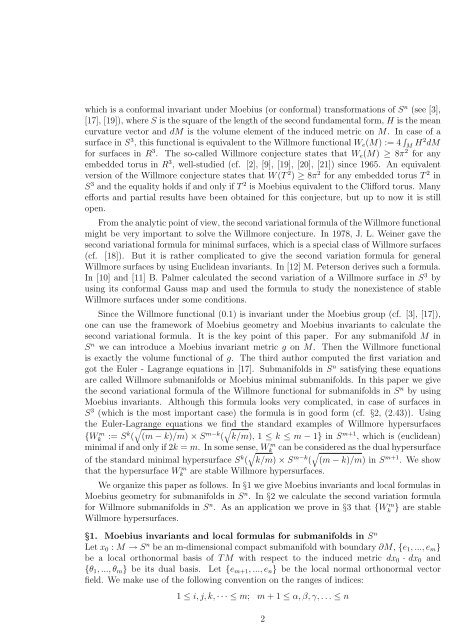The second variational formula for Willmore submanifolds
The second variational formula for Willmore submanifolds
The second variational formula for Willmore submanifolds
You also want an ePaper? Increase the reach of your titles
YUMPU automatically turns print PDFs into web optimized ePapers that Google loves.
which is a con<strong>for</strong>mal invariant under Moebius (or con<strong>for</strong>mal) trans<strong>for</strong>mations of S n (see [3],<br />
[17], [19]), where S is the square of the length of the <strong>second</strong> fundamental <strong>for</strong>m, H is the mean<br />
curvature vector and dM is the volume element of the induced metric on M. In case of a<br />
surface in S 3 , this functional is equivalent to the <strong>Willmore</strong> functional We(M) := 4 �<br />
M H2 dM<br />
<strong>for</strong> surfaces in R 3 . <strong>The</strong> so-called <strong>Willmore</strong> conjecture states that We(M) ≥ 8π 2 <strong>for</strong> any<br />
embedded torus in R 3 , well-studied (cf. [2], [9], [19], [20], [21]) since 1965. An equivalent<br />
version of the <strong>Willmore</strong> conjecture states that W (T 2 ) ≥ 8π 2 <strong>for</strong> any embedded torus T 2 in<br />
S 3 and the equality holds if and only if T 2 is Moebius equivalent to the Clif<strong>for</strong>d torus. Many<br />
ef<strong>for</strong>ts and partial results have been obtained <strong>for</strong> this conjecture, but up to now it is still<br />
open.<br />
From the analytic point of view, the <strong>second</strong> <strong>variational</strong> <strong><strong>for</strong>mula</strong> of the <strong>Willmore</strong> functional<br />
might be very important to solve the <strong>Willmore</strong> conjecture. In 1978, J. L. Weiner gave the<br />
<strong>second</strong> <strong>variational</strong> <strong><strong>for</strong>mula</strong> <strong>for</strong> minimal surfaces, which is a special class of <strong>Willmore</strong> surfaces<br />
(cf. [18]). But it is rather complicated to give the <strong>second</strong> variation <strong><strong>for</strong>mula</strong> <strong>for</strong> general<br />
<strong>Willmore</strong> surfaces by using Euclidean invariants. In [12] M. Peterson derives such a <strong><strong>for</strong>mula</strong>.<br />
In [10] and [11] B. Palmer calculated the <strong>second</strong> variation of a <strong>Willmore</strong> surface in S 3 by<br />
using its con<strong>for</strong>mal Gauss map and used the <strong><strong>for</strong>mula</strong> to study the nonexistence of stable<br />
<strong>Willmore</strong> surfaces under some conditions.<br />
Since the <strong>Willmore</strong> functional (0.1) is invariant under the Moebius group (cf. [3], [17]),<br />
one can use the framework of Moebius geometry and Moebius invariants to calculate the<br />
<strong>second</strong> <strong>variational</strong> <strong><strong>for</strong>mula</strong>. It is the key point of this paper. For any submanifold M in<br />
S n we can introduce a Moebius invariant metric g on M. <strong>The</strong>n the <strong>Willmore</strong> functional<br />
is exactly the volume functional of g. <strong>The</strong> third author computed the first variation and<br />
got the Euler - Lagrange equations in [17]. Submanifolds in S n satisfying these equations<br />
are called <strong>Willmore</strong> <strong>submanifolds</strong> or Moebius minimal <strong>submanifolds</strong>. In this paper we give<br />
the <strong>second</strong> <strong>variational</strong> <strong><strong>for</strong>mula</strong> of the <strong>Willmore</strong> functional <strong>for</strong> <strong>submanifolds</strong> in S n by using<br />
Moebius invariants. Although this <strong><strong>for</strong>mula</strong> looks very complicated, in case of surfaces in<br />
S 3 (which is the most important case) the <strong><strong>for</strong>mula</strong> is in good <strong>for</strong>m (cf. §2, (2.43)). Using<br />
the Euler-Lagrange � equations we find the standard examples of <strong>Willmore</strong> hypersurfaces<br />
(m − k)/m) × Sm−k �<br />
( k/m), 1 ≤ k ≤ m − 1} in Sm+1 , which is (euclidean)<br />
{W m k := Sk (<br />
minimal if and only if 2k = m. In some sense, W m � k can be considered � as the dual hypersurface<br />
of the standard minimal hypersurface S k (<br />
k/m) × S m−k (<br />
that the hypersurface W m k are stable <strong>Willmore</strong> hypersurfaces.<br />
(m − k)/m) in S m+1 . We show<br />
We organize this paper as follows. In §1 we give Moebius invariants and local <strong><strong>for</strong>mula</strong>s in<br />
Moebius geometry <strong>for</strong> <strong>submanifolds</strong> in S n . In §2 we calculate the <strong>second</strong> variation <strong><strong>for</strong>mula</strong><br />
<strong>for</strong> <strong>Willmore</strong> <strong>submanifolds</strong> in S n . As an application we prove in §3 that {W m k } are stable<br />
<strong>Willmore</strong> hypersurfaces.<br />
§1. Moebius invariants and local <strong><strong>for</strong>mula</strong>s <strong>for</strong> <strong>submanifolds</strong> in S n<br />
Let x0 : M → S n be an m-dimensional compact submanifold with boundary ∂M, {e1, ..., em}<br />
be a local orthonormal basis of T M with respect to the induced metric dx0 · dx0 and<br />
{θ1, ..., θm} be its dual basis. Let {em+1, ..., en} be the local normal orthonormal vector<br />
field. We make use of the following convention on the ranges of indices:<br />
1 ≤ i, j, k, · · · ≤ m; m + 1 ≤ α, β, γ, . . . ≤ n<br />
2



